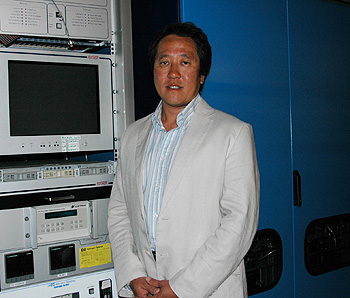Philips Lumileds has donated an advanced system for the synthesis of high-quality semiconductor materials to the Baskin School of Engineering at UC Santa Cruz. This major equipment donation provides important new capacities for materials science research at UC Santa Cruz.
The donation consists of a metal-organic chemical vapor deposition (MOCVD) system originally purchased by Philips Lumileds for about $4.5 million and used to develop compound semiconductor materials for light-emitting diodes (LEDs). Most notably, it was used in the development of the company's white Luxeon LEDs as a replacement for incandescent and fluorescent light bulbs.
The MOCVD system will be installed in the laboratory of Nobuhiko Kobayashi, associate professor of electrical engineering, for use in his research on new materials for solid-state energy conversion devices and other applications.
"This donation is a great example of private industry supporting university education," Kobayashi said. "The system that Lumileds has donated runs perfectly, but no longer met the company's needs for large-scale production. This is equipment that we could not otherwise afford, and it creates new opportunities for our students and research programs."
The AIX 200RF MOCVD system, manufactured by Aixtron AG of Germany, is designed for the production of a particular class of semiconductors with highly uniform layered structures (known as group III-V compound semiconductors). The system's laminar flow design eliminates turbulence, allowing precise control of the chemical compositions of semiconductor thin films and ensuring sharp interfaces between layers.
Kobayashi is developing semiconductor materials for use in devices that convert heat energy into useful electrical power. Such "thermoelectric" devices, if they become efficient enough, could be used to capture waste heat in a wide range of applications. Kobayashi is also investigating new materials for use in photovoltaic cells for solar energy applications.
The MOCVD system will be installed in Kobayashi's Materials Synthesis Laboratory, which is being established in UCSC's facilities at 2300 Delaware Avenue in Santa Cruz (the former Texas Instruments property). Renovation of the facilities to house Kobayashi's lab and a Materials Characterization Laboratory for Art Ramirez, dean of the Baskin School of Engineering, is expected to be completed by the end of 2010.
Philips Lumileds Lighting Company is the world's leading manufacturer of high-power LEDs and a pioneer in the use of solid-state lighting solutions for everyday purposes, including automotive lighting, computer displays, LCD televisions, traffic signals, and general lighting.



